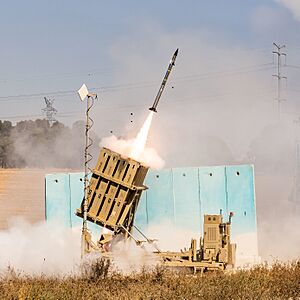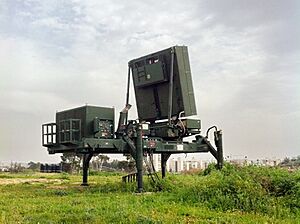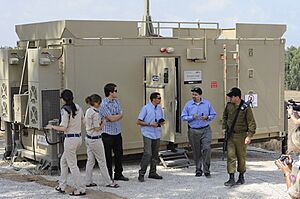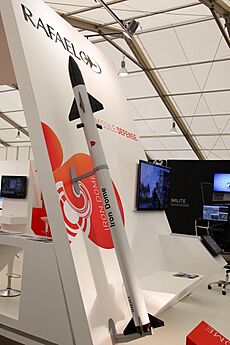Iron Dome facts for kids
Quick facts for kids Iron Dome |
|
|---|---|

Iron Dome launches interceptor, 2021
|
|
| Type | C-RAM and short range air defence system |
| Place of origin | Israel |
| Service history | |
| In service | 2011–present |
| Used by | Israel Defense Forces |
| Wars |
|
| Production history | |
| Designer |
|
| Designed | 2005 |
| Manufacturer |
|
| Unit cost | $50 million per battery $100,000–150,000 per interception |
| Produced | 2011–present |
| No. built | 10 batteries deployed (planned deployment is 15) |
| Specifications | |
| Mass | 90 kg (200 lb) |
| Length | 3 m (9 ft 10 in) |
| Diameter | 160 mm (6.3 in) |
|
Detonation
mechanism |
Proximity fuze |
|
|
|
| Maximum speed | Mach 2.2 |
|
Launch
platform |
Three/four launchers, each carrying 20 interceptors. |
The Iron Dome (Hebrew: כִּפַּת בַּרְזֶל, romanized: Kippat Barzel) is a special defense system from Israel. It is designed to protect areas from short-range rockets and artillery shells. These are usually fired from 4 to 70 kilometres (2–43 mi) away.
The system works by finding and destroying incoming threats before they can hit populated places. It was created by two Israeli companies, Rafael Advanced Defense Systems and Israel Aerospace Industries.
The Iron Dome can work in all kinds of weather, day or night. From 2011 to 2021, the United States helped fund the system. They gave about US$1.6 billion, with another US$1 billion approved in 2022.
The Iron Dome became active on March 27, 2011, near Beersheba. Its first successful interception happened on April 7, 2011. It stopped a rocket launched from Gaza.
By March 2012, reports said the system stopped 90% of rockets aimed at populated areas. By late 2014, it had intercepted over 1,200 rockets. The Iron Dome is also being used on ships to protect gas platforms at sea.
How the Iron Dome Got Its Name
The team that created the Iron Dome needed a good name for it. Colonel S., who led the project, first thought of "Anti-Qassam." But he realized this name might cause problems later.
He talked with his wife to find a better name. She suggested "Tamir" for the interceptor missile. This is a Hebrew acronym meaning "interceptor missile."
For the system itself, they thought of "Golden Dome." "Tamir" was quickly approved. However, "Golden Dome" was seen as too fancy. So, they changed it to "Iron Dome," which sounded strong and protective.
What the Iron Dome Does
The Iron Dome system is built to stop short-range rockets and artillery shells. These can travel up to 70 kilometers (43 mi). It works day and night, even in bad weather. The system can handle many threats at the same time.
The Iron Dome has three main parts that work together:
- Detection & Tracking Radar: This radar system finds rockets after they are launched. It also tracks where they are going. It was built by Elta, an Israeli defense company.
- Battle Management & Weapon Control (BMC): This is the control center. It uses the radar's information to figure out where a rocket will land. If the rocket is a threat to a populated area, the BMC decides to fire an interceptor.
- Missile Firing Unit: This unit launches the Tamir interceptor missile. The Tamir missile has special sensors and fins. These help it move quickly and accurately. This allows it to destroy the incoming rocket in the air. Each Iron Dome battery usually has 3 to 4 launchers. Each launcher holds 20 interceptor missiles.
The radar, called EL/M-2084, tracks the rocket's path. The control center then calculates if the rocket will hit a protected area. Only if it's a threat, a Tamir missile is launched to stop it. Each Iron Dome battery can protect a city area of about 150 square kilometres (58 sq mi).
Images for kids
-
Iron Dome intercepting two rockets over Tel Aviv during Operation Protective Edge, 2014
See also
 In Spanish: Cúpula de Hierro para niños
In Spanish: Cúpula de Hierro para niños
- Iron Spade
- Multi-Mission Launcher











